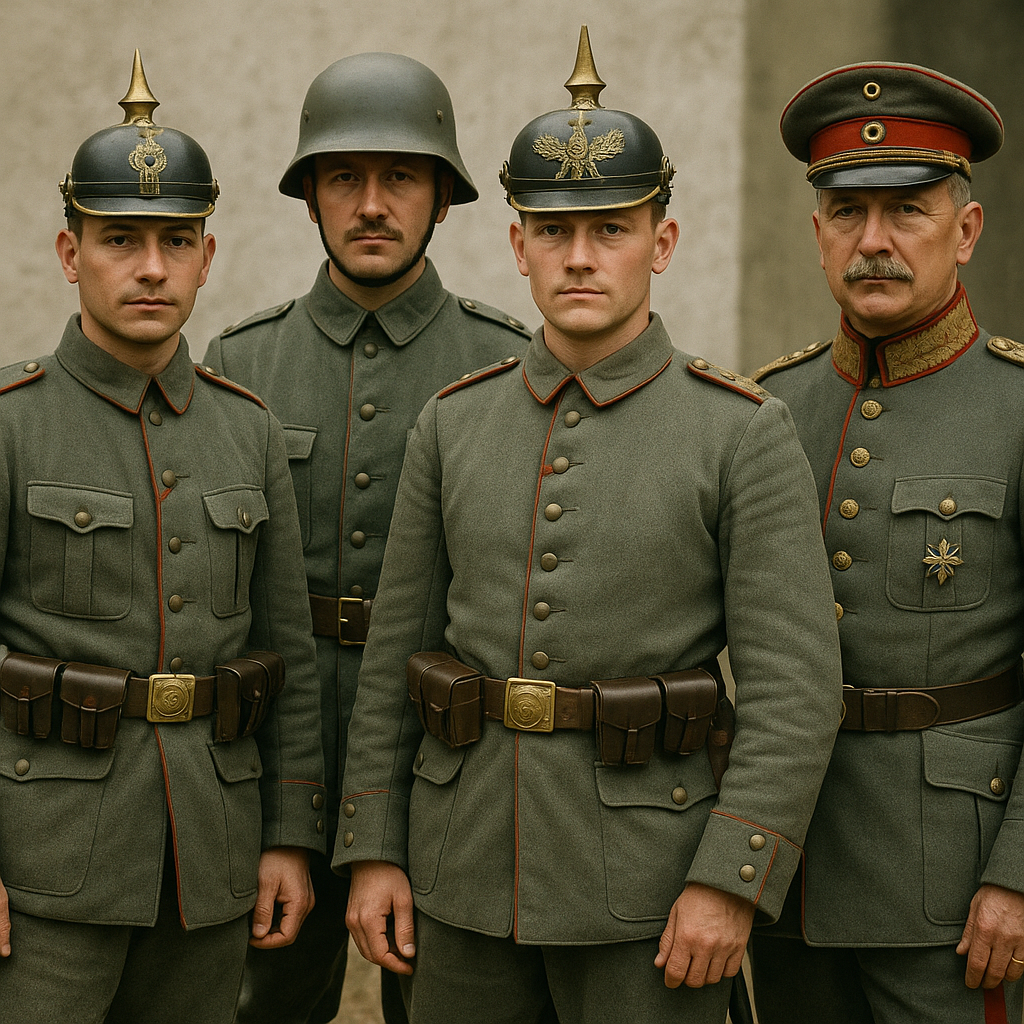
WW1 German Uniform: A Detailed Guide to Ranks, Styles, and History
Published on Jul 03, 2025
WW1 German Uniform: A Detailed Guide to Ranks, Styles, and History
When we think of World War I, the image of soldiers in muddy trenches comes to mind. Among them, the German soldiers stood out with their distinctive uniforms, crafted not only for functionality but also for hierarchical and regimental identity. The WW1 German uniform is a fascinating blend of tradition, utility, and symbolism.
This comprehensive guide delves into everything you need to know about German uniforms in World War 1 — from design elements and field gear to the detailed rank system that defined the Imperial German Army.
1. Historical Context: Why Uniforms Mattered in WW1
World War I was the first truly industrial war, and Germany approached it with a structured military ethos. Uniforms played a key role in maintaining order, discipline, and regimental pride. Unlike earlier wars, WW1 demanded uniforms that were durable, weather-appropriate, and capable of blending with the environment — but still rich in tradition.
2. Key Elements of the WW1 German Uniform
German soldiers, or "Feldgrau" (field gray) troops, wore some of the most recognizable uniforms of the era. Below are the core elements:
A. Tunics (Feldbluse)
- Color: Feldgrau (gray-green)
- Material: Wool, designed for durability in cold trenches
- Features: Stand-and-fall collar, pleated pockets, and sometimes red piping for earlier models
B. Trousers (Hosen)
- Straight-cut, matching the tunic in feldgrau
- Some had reinforcements at the knees and seat
C. Headgear
- Pickelhaube (spiked helmet): Early-war iconic leather helmet
- Stahlhelm (steel helmet): Introduced in 1916, offering better protection
D. Boots and Gaiters
- Marching boots (Marschstiefel) made of tough leather
- Gaiters or puttees were used to protect the lower legs
E. Equipment and Webbing
- Bread bag, water bottle, ammunition pouches, entrenching tool
- Leather belts with a "Gott mit uns" (God with us) buckle
3. WW1 German Ranks and Insignia
One of the most critical aspects of any uniform is rank identification. The German Army maintained a detailed and structured rank system. Here's how ranks were typically indicated:
A. Enlisted Men and Non-Commissioned Officers (NCOs)
- Gefreiter: Distinguished by a small lace or cuff piping
- Unteroffizier: Chevrons and colored shoulder straps
- Feldwebel: Silver braid and piping on the collar and cuffs
B. Officers
- Leutnant, Oberleutnant, Hauptmann: Rank indicated via shoulder boards with pips
- Officers had better-quality fabric and often carried sidearms
- Their tunics were tailored, with dark green collars and cuffs
C. Generals
- Richly decorated uniforms with red collars, gold braids, and unique buttons
- Wore privately tailored uniforms with distinctive insignia
Uniforms and rank insignia helped maintain battlefield order, even amid the chaos of trench warfare.
4. Regimental Differences and Special Units
Not all German uniforms were the same. Variations occurred based on:
- Region (Prussia, Bavaria, Saxony, Württemberg)
- Unit Type (Infantry, Artillery, Jägers, Uhlans)
- Elite Troops: Such as the Sturmtruppen (Stormtroopers) wore lighter gear and adapted uniforms for mobility
Special units often had unique collar tabs, shoulder straps, or helmet badges. Collectors often seek these differences to identify regimental history.
5. Evolution of the German Uniform During the War
1914: Parade-Ready Elegance
- High-gloss Pickelhaube helmets
- Bright red piping and brass buttons
1915–1916: Functional Adaptations
- Transition to duller colors for camouflage
- Phasing out of leather equipment for canvas
1916–1918: Stahlhelm Era
- Steel helmets became standard
- Uniforms became more uniform and practical, losing much of their decorative flair
6. Collecting and Reproducing WW1 German Uniforms
Today, WW1 German uniforms are highly valued among:
- Collectors
- Historical reenactors
- Military historians
- Film and theater costume designers
Websites like Paddelaters.com provide authentic reproductions, allowing enthusiasts to own a piece of history. Whether you're looking for a Feldbluse, Pickelhaube, or insignia, accurate detailing is key.
7. WW1 German Uniforms in Modern Culture
From movies like All Quiet on the Western Front to series like 1917, German WW1 uniforms are often depicted with attention to historical accuracy. The sight of the Stahlhelm or Pickelhaube is instantly recognizable and adds authenticity to any depiction of the Great War.
8. Why the WW1 German Uniform Still Captivates
The WW1 German uniform isn't just a relic of the past — it's a symbol of:
- Military discipline
- Cultural identity
- Industrial-era craftsmanship
Each stitch, button, and insignia tells a story — of a soldier, a regiment, a nation at war.
Conclusion: More Than Just Fabric
Understanding the WW1 German uniform is about more than identifying wool tunics and metal helmets. It's about grasping how a powerful nation dressed its soldiers to serve, fight, and endure in one of the most brutal wars in history.
Whether you're a collector, a historian, or just a curious visitor, diving into the details of German ranks, tunics, and headgear reveals a powerful narrative of war, identity, and evolution.
Explore the full collection of authentic WW1 German uniforms, ranks, and accessories at Paddelaters.com — where history meets craftsmanship.
